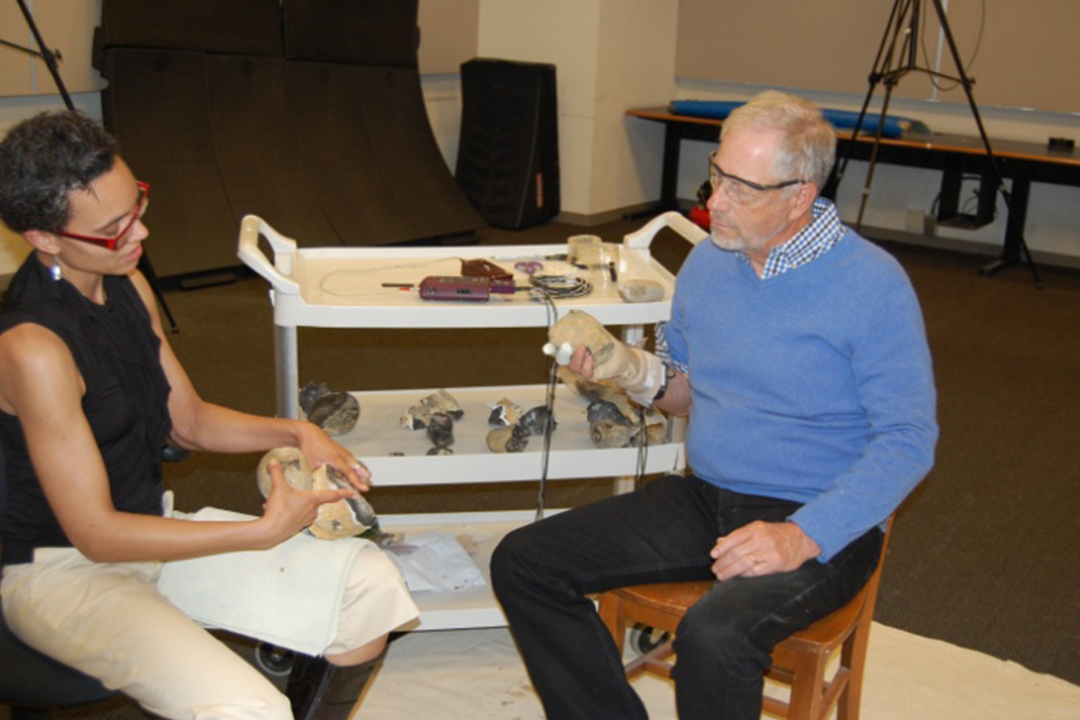Why were some early humans able to shape stone tools while others were not? Erin Marie Williams, a post-doctoral scientist in hominid paleobiology, is banging rocks together to find out.
While it sounds—literally—like an activity fit for a caveman, the rock banging is part of sophisticated research project. And now, thanks to the generosity of Michael Thacher, BA ’70, and his wife, Rhonda, there is a new instrument to help Williams and Professor of Anthropology Brian Richmond undertake experiments that reveal how humans use their arms and hands to create stone tools.
In Williams’ experiments, a test subject is fitted with finger and wrists sensors, protected by a glove. These sensors collect information, including the levels of energy and pressure the subject uses while gripping a tool or forming a tool by knocking a rock against another rock or bone. The information is fed to a control box, which transfers it to software on Williams’ computer, mapping the data into graphs and charts.
Without the box, the sensors would not be able to communicate with the software. And without the Thachers, there would be no box.
To enable Williams and Richmond to conduct their experiments without relying on borrowed equipment from another university, the Thachers donated $20,000 to Columbian College to purchase a Pliance pressure measurement control box (ppm).
“I’ve long been fascinated by the origins of Homo sapiens—how and why our brains grew, our hands and thumbs became so useful, and we became bipedal,” said Michael Thacher. “This research explores many of these areas. Funding the purchase of a ppm seemed like it could really make a practical difference in the lab.”
The Thachers' gift also made possible a summer research trip to Ileret, Kenya, where some of the first tools were made 2.6 million years ago. Richmond took a group of graduates, undergraduates, and post-doctoral fellows from GW and the Smithsonian Institution to test the ppm system on rocks native to the region.
Back in the lab, Williams looks at the size and shape of flakes (sharp stone tools), energetic efficiency, and target accuracy. By recording the pressure points and grips as test subjects create stone tools, she can understand how raw materials and upper-limb biomechanics affect stone tool production. Her findings also help explain how stone tool production and use connects to the evolution of the human hand and wrist.
Williams’ work is not the first that has attracted Michael Thacher’s attention. A member of the National Council for Arts and Sciences since 2000, he established the Thacher Fund for Philosophy in 2001 for use at the discretion of the chair of the Department of Philosophy. He also supports GW through annual contributions to the Department of Philosophy and the Department of Anthropology.
“I give to GW for several reasons,” Thacher said. “I’m grateful to the university for offering me a second chance and for stimulating and expanding my intellect. I want to have an impact on the university and to set an example that continues in the years ahead.
“And I give because so many others gave before me,” he added. “Their generosity made my education possible. Now it’s my turn to help new generations of students and researchers.”
(In photo, Erin Marie Williams demonstrates use of equipment donated by Michael Thacher, right.)


